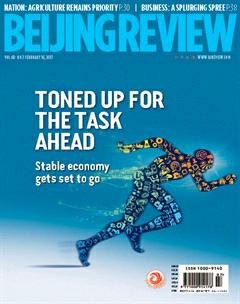Economic Paradigm Shift Underway
The growth rate of Chinas economy in 2016 took the lead in the world once again. The 6.7-percent growth not only indicates Chinas supply-side reform has been effective, but also bodes well for the global economy.
The sound performance is attributable to the macroeconomic policy adopted by the Central Government. China implemented supply-side structural reform in 2016 with a focus on five tasks: cutting excess industrial capacity, downsizing housing inventory, reducing leverage, lowering corporate costs and improving weak economic links. The reform has spurred economic vitality and reduced factors hindering healthy economic growth.
Chinas economic structure has been optimized, its development model is being transformed and new growth drivers have been developed. The service sector accounted for nearly two thirds of the nations economic growth, and hi-tech industries also expanded rapidly. Energy consumption per unit of GDP declined by 5 percent in 2016, while clean energy made up a higher proportion of the energy mix.
The year 2016 marked the beginning of the governments 13th Five-Year Plan, which lays out social and economic development objectives for 2016 to 2020. The bottoming out of the economy in 2016 marked a good start for the period.
It also presents a powerful counterargument to theories about Chinas economy collapsing and bolsters confidence in sustainable global growth. Against the backdrop of its stable and improved domestic economy, China will bring more development opportunities to other countries. The China-proposed Silk Road Economic Belt and 21st-Century Maritime Silk Road Initiative, for instance, is gaining traction as it helps promote connectivity and prosperity around the world.
However, it should also be noted that the foundation for steady growth is not solid enough amid the complex domestic and international economic environment. The Chinese Government should continue to prevent possible risks caused by huge market fluctuations and the influence of global uncertainty.
China should continue to promote balanced and sustainable economic growth through structural adjustment and growth model transformation. It should seek progress while keeping performance stable, focus on improving the quality and efficiency of growth, and persist in its supply-side reform.
Chinas economy has moved into a crucial stage known as the “new normal,” as the country tries to shift from an export- and investment-driven growth model to one that prioritizes consumption, innovation and the service sector.
This transition is bound to be a bumpy process. However, plenty of indications, including the recently released 2016 economic statistics, have shown that China is going in the right direction.

